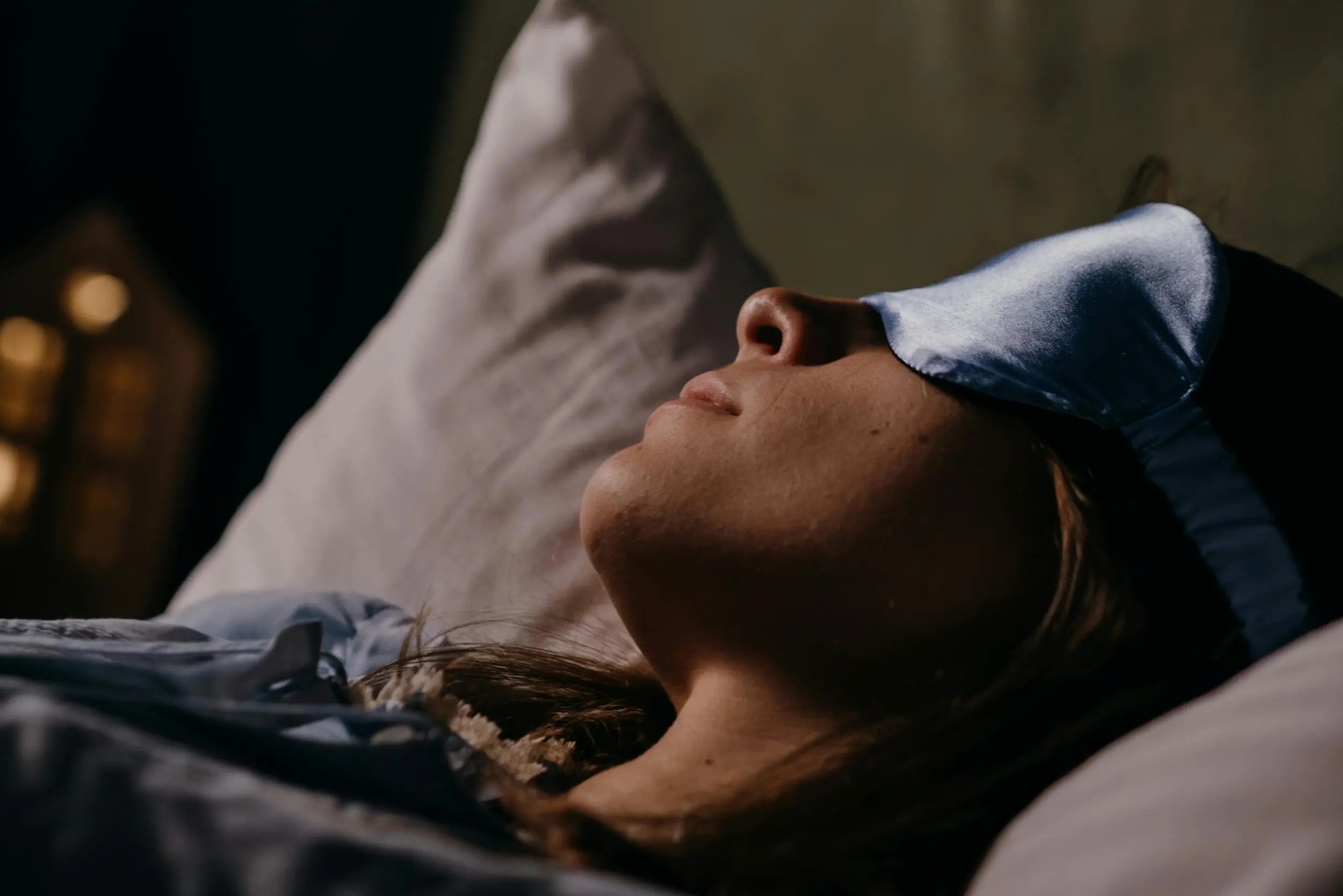
If you're considering psilocybin therapy and have never experienced altered states of consciousness, chances are you're also experiencing some fear or hesitation about what the actual session will be like. These feelings are completely normal—and also often based on misconceptions from anti-drug culture and other stigmas that get passed around society regarding recreational uses.
Many people imagine they'll be trapped in a terrifying hallucination, seeing disturbing imagery, completely losing touch with reality, or unable to communicate. They picture scenes from movies where characters are writhing around, screaming, or completely incapacitated.
Here's the truth: The vast majority of properly dosed psilocybin therapy sessions are calm, quiet, introspective experiences that still rank as exceptionally profound. Most clients spend their session lying down with eye masks or closed eyes, though some clients look up at the ceiing, or even stand or pace around the room while thinking out loud. The key hallmark of a psilocybin therapy is the ability to do deep cognitive and emotional processing, often accessing areas of your memory or psyche you realize just weren't possible in normal day to day life. You might cry as you release grief you've been holding for years. You might have insights about your childhood or your patterns. You might feel waves of emotion—sadness, relief, deep self-love and a feeling of connectedness to others and the world.
But you're unlikely to see pink elephants, encounter demons, or lose your grip on reality in a controlled, strategically designed therapeutic session. Let's walk through what actually happens so you can approach your session with realistic expectations rather than Hollywood-fueled fears.
Before We Begin: Dispelling the Myths
First, let's address what psilocybin therapy is NOT:
It's not recreational "tripping." The therapeutic setting, intention, preparation, and facilitation create an entirely different experience than taking mushrooms at a festival or with friends. Context matters enormously.
It's not about visual hallucinations. While you may experience some enhanced colors, patterns, or imagery with closed eyes, most of the experience happens in your mind and emotions, not in dramatic visual distortions. The therapeutic doses used in clinical settings are calibrated for insight and emotional processing, not for intense perceptual effects.
It's not about "going crazy" or losing control. You remain fundamentally yourself throughout the experience. You can communicate with your facilitator, you understand where you are (though you will go in waves that feel like being pulled into a good movie, then occasionally 'popping back out'). Most clients maintain a thread of awareness even during the deepest parts of your journey.
It's not inherently terrifying. While some moments can be emotionally challenging (which is often where the healing happens), the overall arc of most sessions is one of increasing peace, release, and integration.
Now let's talk about what it actually IS.
The Setting: Your Safe Container
Your psilocybin session takes place in a comfortable, private room at a licensed service center. The environment is designed to be calming and safe—think more spa-like than clinical. Soft lighting, comfortable furniture, blankets, and a peaceful atmosphere.
Your licensed facilitator is with you for the entire session. They're not there to guide your experience or tell you what to think about—they're there to hold space, ensure your safety, and support you if you need anything. Many clients describe their facilitator as a reassuring presence in the background, available but not intrusive. Be wary of any facilitator who wishes to 'perform'.
You'll typically lie down on a comfortable couch or bed. Most clients use eyeshades to minimize visual distractions and headphones with carefully curated music to support the emotional journey. The eyeshades and music help you turn inward rather than being distracted by the external environment.
This might sound isolating, but most clients find it deeply supportive. The darkness and music create a nurturing, focused container for your inner experience to unfold without external distractions.
The Timeline: What to Expect Hour by Hour
Let's walk through a typical session timeline so you know what to expect:
Minutes 0-15: Consumption and Settling
You'll consume your dose of psilocybin—typically in finely-ground, homogenized mushroom powder form stirred into some juice, tea or cocoa—with the service center support staff, and usually your facilitator present as well. (It's important to know that your facilitator cannot prepare or help you consume your dose under Oregon's model.) This is a moment of intention-setting. Many clients feel nervous at this stage, which is completely normal. All psilocybin product in Oregon is grown by OHA-licensed manufacturers and tested for potency and purity.
After consuming, you'll settle in to your room and wait for onset, which usually takes a little while. Your facilitator might do a brief check-in about comfort and readiness, or you may request them to guide you through some breathwork or meditation. You'll have some music going in the room, and atsomepoint you may want to lay back and close your eyes or put on eye shades. When it is obvious you are ready to start going inward, your facilitator should give you space to begin your journey and will usually limit conversation at that point.
Minutes 15-45: The Come-Up
You'll begin to notice subtle effects—perhaps a slight shift in your body sensations, a gentle awareness that something is changing. This phase can bring some nervousness as you feel yourself moving into altered consciousness. Many clients describe it as similar to the feeling before takeoff on an airplane—anticipatory energy.
Your rational mind might be very active during this phase: "Am I feeling it yet?" "Is this going to be okay?" "What if..." This is normal. Just breathe and allow the experience to unfold.
Typically, you'll feel psilocybin's effects in your body first. This can feel like tingly fingers, heavy-feeling limbs, some mild light-headedness. As the effects deepen, some clients will get some muscle twitches in their legs, or their teeth may want to chatter a bit. These are also all normal sensorimotor reactions to initial stimulation of serotonin receptors. Whether you have a deeply somatic response, or nothing, is all within the range of normal and can indicate areas in your body you are holding stress and tension.
Mentally and emotionally, you'll also likely start having some memories or emotions come up. You may want to cry and giggle at the same time (this is normal). You may start reflecting on your life in timeline format (also normal). You may have unexpected people or events suddenly pop into your head (also normal!). Occasionally, something we call 'undeniably trippy' will happen - you may see a mind's eye visual of something symbolic, like stairs or clouds or water or fire or space. Occasionally, you may sense a presence in the room after you cross the consciousness-altering threshold. This, too, is completely normal, and indicative of a more 'mystical' experience. Not everyone experiences mystical events during their journeys. Some are more grounded in memories and emotions.
Hour 1-2: Deepening
This is where the experience typically intensifies from what you were already beginning to experience during initial onset. You might experience:
- Emotional waves: Sadness, grief, or other emotions may surface. Many clients cry during this phase—not from distress, but from release. It's like finally being able to let out emotions you've been holding for years, at a deeper and more cleansing level.
- Cognitive insights: You might have thoughts like "Oh, that's why I've always done that" or "I can see now how my childhood shaped this pattern." These insights often feel obvious in the moment but are genuinely revelatory.
- Shedding of Narratives & Labels: You may feel certain labels or messages literally dissolving out of your brain. This is psilocybin's powerful effects on the Default Mode Network that you're feeling in real time. Psilocybin tends to reveal 'the real you', and provide clarity into authentic values. Superficial or maladaptive narratives, as well as labels society has 'pinned' you with, will very often simply disappear. One client described it as "I feel like the medicine is scrubbing my brain of everything harmful".
- Physical sensations: Some tingling, warmth, or unusual body sensations are common. These typically aren't uncomfortable—just different. Occasionally, clients will have a deeper somatic experience including muscle jerks, jaw clenching or a burning sensation in muscles, particularly ones holding stress and tension. It's important to listen to somatic messages as well, and relax into them.
- Mild visuals: With eyes closed, you might see colors, patterns, or gentle imagery. This is usually more like watching soft kaleidoscope patterns than seeing concrete "hallucinations." With eyes open (if you remove the eyeshades), things might look slightly different—colors more vivid, patterns more noticeable—but you won't see entire objects that aren't there. Everything feels 'melty' and soft.
During this phase, sommany clients are completely quiet and introspective as they listen for messages, focus on their internal world, and do the active coping that is asked of them. Other clients may verbally process, with their facilitator taking notes—talking through memories, insights, or emotions as they arise. Both are normal and equally effective. Don't force talking or not talking, just do what comes naturally.
Hours 2-3: The Peak
This is the heart of the therapeutic experience. For most people, this phase involves:
- Deep introspection: You're working through core memories, beliefs, or emotional material. This might involve revisiting childhood experiences, processing grief, or examining the roots of your anxiety or depression.
- Emotional release: This is often when the deepest crying, grieving, or emotional catharsis happens. It can feel like finally putting down a heavy burden you've been carrying for decades.
- Cognitive clarity: Many clients describe suddenly "seeing" patterns that have been invisible their whole lives. The connections between childhood experiences and current behaviors become clear.
- Profound peace: Paradoxically, even when processing difficult material, many clients report an underlying sense of safety and okayness. You might be crying about something painful while simultaneously feeling that it's going to be okay.
What this phase does NOT typically look like: You're not generally unable to communicate (though verbal changes do occur, and forming words may feel more difficult). Most clients also do not see frightening mind's eye visuals, however it is important to be aware that should you do see something that seems scary, to remember it is symbolic of your own fear, and just like in a lucid dream, you can interact with that thing. This is a deep form of integration, anti-dissociation and shadow work. However, most clients have more images of beautiful, love and light, especially in the last half of their journeys. It's important to accept and stay open to whatever comes. This is the medicine telling you where you most need to heal.
Throughout all of this, your facilitator should remain present and attentive, yet quiet and unobtrusive. If you need to use the restroom, communicate discomfort, or ask for support, you absolutely can. You're not incapacitated. Professional facilitators will have the maturity to let the client completely lead what they need in the experience. They will not try to actively participate in or direct the client's journey, or keep bringing the client's attention back to themselves.
Hours 3-5: Integration and Softening
Psilocybin hits hits its peak intensity around the 1.5 to 2 hour mark. As the intensity begins to soften, you enter an integration and reflection phase. This often feels like:
- Gentle processing: You're still having insights and emotional releases, but they're gentler, less intense.
- Gratitude and relief: Many clients report feeling grateful, lighter, or relieved during this phase. There's often a sense of "I did it" and "I'm okay"...and often times "wow, what was I scared of?Why didn't I do this sooner? Everyone needs to do this!"
- Cognitive clarity: Your thinking becomes clearer, though you're still in an altered state. You might have important realizations about changes you want to make or new perspectives you want to maintain.
- Physical rest: Some clients feel tired and simply rest quietly during this phase. Others remain actively processing.
Hours 5-6 (occasionally, 7 hours for slow metabolizers): Return and Grounding
Eventually, you'll notice you're "coming back." The altered state gradually lifts, though you will likely still feel somewhat different from baseline. There is a difference between still feeling the medicine's effects (being in a slightly altered state), and simply feeling different from before, or being fatigued, emotionally tender, etc. This is a time for:
- Grounding: Your facilitator will help you re-orient to the physical space and the present moment, if needed. They will also get you some food or water if you need.
- Initial reflections: You might talk with your facilitator about key insights or experiences from your session. It's okay if you don't feel like talking right away.
- Physical care: Eating a light snack, drinking water, and gently moving your body helps complete the transition back.
- Assessing readiness: Your facilitator will ensure you're grounded enough to leave the service center safely.
Many clients describe feeling emotionally tender, physically tired, but mentally clearer and emotionally lighter at the end of their session.
What Most Sessions Actually Look Like
Based on thousands of clients served in Oregon's regulated psilocybin program, here's what the typical session actually involves:
80% of clients spend most of their session quietly lying down with eyeshades or just closed eyes, doing internal processing. They might shift positions occasionally or get up to use the restroom in between 'cycles', but the experience is predominantly internal and contemplative. Rooms are designed to remove distractions for this purpose.
60-70% of clients cry at some point during their session—not from distress but from release, or for self-compassion as they see their 'old selves' and how hard they tried. They're processing grief, childhood pain, or emotions they've been suppressing. This crying is often described as cathartic and healing rather than overwhelming. It's important to remember crying isn't a form of 'weakness', which is an extremely harmful societal narrative. Sadness and crying are crucial emotions for LETTING GO.
Many clients (roughly 50%) remain verbal and communicative throughout the experience - though it's not at all an indicator of failure if they are quiet. Whether a client is predominantly verbal or not, the vast majority can talk to their facilitator when needed, describe what they're experiencing, or ask for support. Communication might be slower or more thoughtful than usual, but it's not lost.
Visual phenomena, when they occur, are usually subtle. Closed-eye patterns, enhanced colors, or gentle imagery are common. Dramatic hallucinations of concrete objects, people, or scenarios are rare at therapeutic doses.
The emotions that surface are usually familiar ones: Sadness about specific losses, anger about how you were treated, fear about specific situations. These aren't alien or incomprehensible emotions—they're your emotions, finally able to be felt and released.
The Role of "Difficult" Experiences
Now let's address something important: sometimes psilocybin sessions involve uncomfortable or challenging moments. This isn't a sign that something is wrong—it's often where the deepest healing happens.
"Difficult" in psilocybin therapy usually means:
- Facing something you've been avoiding or has been repressed: A memory, emotion, or truth that's been locked away. It's difficult because you're finally looking at it, not because psilocybin created something scary.
- Feeling intense emotions: Deep grief, long-suppressed anger, or profound sadness can be uncomfortable. But there's a difference between discomfort and danger. You're safe while feeling these emotions—perhaps for the first time ever.
- Ego dissolution: Sometimes the sense of your fixed identity softens or dissolves temporarily. This can be disconcerting if you're not expecting it, but it's not dangerous. It's often described afterward as profoundly freeing.
Importantly, difficulty during a psilocybin session is different from having a "bad trip." In recreational settings with no support, polydrug factors, and difficult content can spiral into panic or fear. In a therapeutic setting with a trained facilitator and thoughtful dosing, difficult moments are held, processed, and integrated. Your facilitator knows how to support you through challenging experiences when needed.
Most clients who have difficult moments during their sessions describe them afterward as the most valuable parts of their healing. One client said: "The hardest part of my session—when I was really facing my childhood trauma—was also when I finally felt it shift and release. It was hard, but it wasn't bad. It was necessary for my complete freedom moving forward."
Your Facilitator: The Safety Net You Probably Won't Need
Your facilitator is trained to:
- Recognize if you're becoming dysregulated and provide grounding support
- Differentiate between productive emotional processing and overwhelm
- Offer reassurance and presence without interfering with your process
- Adjust the environment (lighting, music, temperature) to support your comfort
- Help you navigate any challenging moments with calm, experienced guidance
Most of the time, facilitators simply hold space—sitting nearby, responding to any client requests for support, and taking session notes. They're like a skilled lifeguard: trained and attentive, but hoping they won't need to intervene because you're swimming just fine.
Why It's Gentler Than Many People Fear
Several factors make therapeutic psilocybin sessions far gentler than most people anticipate:
1. Proper dosing: Licensed providers use pharmaceutical-grade, precisely dosed psilocybin. You're not accidentally taking too much, and you can start with a more moderate dose if you're nervous. Facilitaor knowledge and skill in this area is crucial. Inexperienced facilitators will sometimes get nervous about client disappointment and end up throwing too much medicine at the experience as a cover tactic to their own lack of knowledge of experience. This is not helpful, and more is not always better.
2. Set and setting: The safe, comfortable environment and the presence of a trained facilitator completely changes the experience compared to uncontrolled recreational use. Look for Centers that have comfortable areas to lay. Being uncomfortable or squashed into a tiny couch or hard floor mat for hours is a huge distraction to internal work.
3. Preparation: The work you do before your session—understanding what to expect, clarifying your intentions, addressing your fears—dramatically reduces the likelihood of a difficult experience. Facilitators have noted that the amount of engagement a client has during their preparation sessions directly correlates to the amount of engagement they will have toward the administration session (which directly translates to positive outcome).
4. Your body's natural wisdom: Your psyche tends to show you what you're ready to see. Psilocybin doesn't force experiences on you—it reveals what's already there and ready to be processed. Occasionally, especially with clients who are already dissociated or 'flat', multiple sessions may be necessary to gently get you back in touch with your inner world in a way that feels safe to your nervous system. This is mostly true for major depression, dissociation caused by trauma, and severe, chronic substance abuse.
5. You're not actually losing control...you're gaining it: Even at the peak of the experience, a part of you remains aware that you're in a psilocybin session, that you're safe, and that this is temporary. You haven't left reality—you've just entered a different mode of processing it. By shedding harmful narratives, beliefs and behaviors that actually are controlling YOU, you end up with far more freedom and control over your life after a productive psilocybin therapy session.
What Clients Say Afterward
The most common post-session reflections we hear are:
- "That was much gentler than I expected."
- "I was so afraid going in, but it was actually really peaceful."
- "The difficult parts were hard but manageable—and so worth it."
- "I cried a lot, but it felt good. Like finally releasing something I'd been holding forever."
- "I kept waiting for the scary part, and it never came. It was just... deep work."
Very few clients report their sessions as traumatic or overwhelming. The vast majority describe them as intense in a productive way—like a really deep therapy session where you finally break through, not like being subjected to something terrifying.
Practical Preparation to Ease Your Fear
If you're still feeling nervous (which, again, is totally normal), here are practical things that help:
Trust your preparation: The work you do with your facilitator before your session is designed to prepare you emotionally and practically. Trust that preparation.
Remember you can communicate: If you need something during your session—water, a bathroom break, reassurance—you can ask. You're not trapped or incapacitated.
Start with a moderate dose: If fear is significant, discuss a more moderate initial dose with your facilitator. There's no shame in building up gradually, starting with a gentle initial dose and then having a booster (second) dose on hand to optionally take after about 45 minutes.
Understand that challenging ≠ harmful: Discomfort during emotional processing is not the same as danger. You might feel sad, but you're safe while feeling sad.
Know it's temporary: The experience lasts 4-6 hours. That might sound long, but knowing there's a definite endpoint can be reassuring.
The Bottom Line
Psilocybin therapy sessions are far less frightening and far more manageable than most people fear. The experience is primarily one of deep introspection, emotional processing, and often profound relief.
You're not going to lose your mind. You're not going to see terrifying things. You're not going to be unable to function or communicate.
You ARE going to do deep emotional work. You ARE going to feel things you've been avoiding. You ARE going to face some uncomfortable truths.
But you'll do all of that from a place of fundamental safety, with professional support, in an environment designed to hold you through the process.
The fear before a psilocybin session is understandable—you're preparing to do something new and unfamiliar that you've probably heard scary stories about. But the reality is so much gentler, so much more manageable, and so much more healing than the fear suggests.
Thousands of people in Oregon have now completed psilocybin therapy sessions. The 99.9% safety record speaks for itself. What most people discover is that their fear of the session was far worse than the session itself—and that the healing on the other side was worth every moment of discomfort.
Still have questions or concerns about what your session might be like? Schedule a consultation with Fractal Health to discuss your specific fears and learn exactly how we support clients through safe, effective therapeutic experiences.






.webp)
